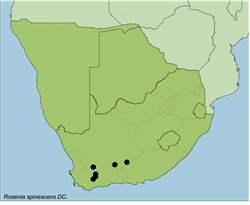Names and synonyms
Rosenia spinescens DC.=Nestlera dregeana Harv., nom. superfl.=Nestlera spinescens (DC.) Druce =Relhania lanata Compton
Type
Drege, Nieuwveld, between Rhinosterkop and Ganzefontein, 3500-4500 ft. (G-DC, BM, G, P, S, W).
Derivation of names
Rosenia = after E. Rosen (1714-1796), Swedish physician, botanist and professor of practical medicine.spinosus = thorny
Diagnostic characters
Leaves glandular, with stalked glandsInvolucral bracts somewhat spathulate, limb with membranous marginsShort branches below the capitula become leafless and spinescent in older plants
Description
Spiny shrubs, moderately and often sub-dichotomously branched, upper branches transformed into straight, rigid spines, spines 10-50 mm long, leafy at first but soon dropping the leaves. Leaves flat or somewhat canaliculate, mid-ribbed, narrowly obovate-oblong-spatulate, 3-15 x 1-4.5 mm, tomentose and often glandular with stalked glands along the margins and lower mid-rib, greyish green. Capitula mostly solitary, involucre widely cup- to bell-shaped, 4-14 mm wide. Receptacle epaleate, but sometimes with short scales, occasionally paleate with paleae up to 4.5 mm long. Involucral bracts 35-60, outer ovate-oblong, inner gradually longer and obovate-oblong -spatulate, apically spreading and brownish with scarious margins, up to 10 mm long, up to 3.5 mm wide. Ray florets 12-25, lamina 5.5-12 mm long. Disc florets 25-75, corolla 4.5-6.8 mm long. Pappus a crown of scales, up to 1 mm long, often also with 1-2 barbellate bristles, up to 7 mm long. Cypsela circular or somewhat angular in cross section, narrowly oblong, 4-6 x 0.6-1 mm, glabrous and smooth, pilose near apex.
Flowering time
Mainly from August to September.
Distribution
Mainly occurs in the Great Karoo from Whitehill to Murraysburg in the southern parts of the Nieuwveld range; in the Beaufort West, Laingsburg and Sutherland divisions.Known from more than 10 specimens.
Habitat
It grows in stony or rocky karoo veld.
Notes
The spines are not always well developed and distinctive on specimens, but this species can easily be recognised by the stalked glands on stems and leaves when spines are not obvious.Specimens of R. spinescens are quite variable in the size of leaves, capitula and presentation of spines.
References
BREMER, K. 1976. The genus Rosenia (Compositae). Botaniska Notiser 129: 97-111.GLEN, H.F. 2004. SAPPI, What's in a Name? The Meanings of the Botanical Names of Trees. Jacana.
